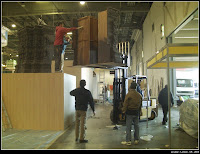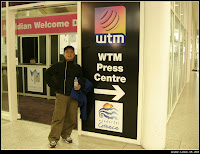So you're going to have a booth at a trade show. How exciting - or how terrifying - depending on your state of mind!
First of all - remain calm - you're not the first person to do this. There's some easy to follow tips that will ensure success at the show, and give you follow up business too.
Preparation ahead of time is important. Gather all the supplies you'll need. Brochures, business cards, product samples, entry forms for a draw, professional signs and any audio visual equipment you'll need. Be sure to ask for electricity from show organizers well in advance if you will need it. Also, do not let any piece of marketing literature leave your booth without contact information on it - people MUST know how to get in touch with you after the show.
Make your booth look GREAT! It doesn't have to cost a lot of money - ask a friend whose got a sense of style to help you create something that is eye catching but doesn't cost too much. Don't over crowd your display area because people get overwhelmed and pass by; but on the other hand, don't have so little that people think there's nothing to see. Make sure your sign is professionally printed and hung straight!
Once you’ve set up your booth, stand back about 20 feet and objectively take a look at it. Is it welcoming? Is your sign easy to read? Can people tell what you do BEFORE they get to your booth? These are critical issues that you need to answer before the show.
At the show be friendly - wear a name tag and smile. When people come by your booth, you’ve a VERY short period of time to catch their attention. This is the time you need to have something to say. Create a 15 – 20 second “speech” you can recite. For example, if you sell children’s wall murals, why not try this, “Hi there, I’m Julie Lewis and I use paint to create a magical room for your child or an experience that will take you anywhere in the world with my wall murals.” Sounds more exciting that “I paint wall murals”, doesn’t it?
Let’s try another one, “Hello, I’m Alex Brown and I create marketing programs for my clients that really make them be unforgettable!”
By having something prepared in advance, you’re always ready to gain a new client! If you’re unprepared you will look very unprofessional.
Encourage everyone who walks by to take a brochure, sample your product or enter a free draw. ALWAYS have a free draw - give away a good prize - it doesn't have to be expensive. Use the draw entry forms to follow up on with a sales letter, or put on a mailing list for future business.
I'm always amazed at the number of business people at trade shows who don't have a draw, and then
have no way to follow up with potential customers! Create your draw entry form so that it will provide you with more information than just name and address. Get the standard contact information, but also ask questions specific to your products or service. Something like: "are you planning to buy our type of product in the next six months?" or "have you heard of our product before?" - Things like that will give you a conversation starter when you call them after the show. If you worry about "bothering people" by calling them, you can add the following at the bottom of the entry: “I do not wish to be contacted.” – and be sure to leave a check box next to the sentence. This allows those people who really only entered the draw just to get a prize to be easily weeded out. This way you don’t waste your time isn’t wasted calling them, and you don’t bother people who don’t wish to be called. Most people do NOT check off the box that says “I do not wish to be contacted – so don’t worry that you will not have anyone to call.
Make sure that pick up business cards from all the other exhibitors at the trade show as well. Some may be immediate customers, while others may have the potential to become strategic partners.
After the show - call or contact all those people who stopped by your booth, and indicated an interest in one of your products or services. Try to get in touch with them within a week at the most. Keep track of those people who find you through the trade show and later buy from you. Figure out how much your expenses were to be in the show (include booth rental, your time, items for your display, gas to get there, parking, etc.) Now figure out the profit (include expenses for materials and supplies to make your product - don't forget shipping & packaging). Now you have your ROI (return on investment). THIS IS A CRITICAL number that will allow you to assess whether or not it is worth doing this trade show again.
Some trade shows prohibit direct selling at the show - they only allow you to take orders. In this case you MUST do follow up. Do NOT assume that people will call you - they WON'T! If you don't believe me - answer this: How many times have YOU called someone you met at a trade show, even if you just adored their product? If you don't like doing follow up phone calls, hire someone to do it for you. If you're not going to do the calls at all - don't even bother doing the show - you're wasting time and money.
Be sure to send a hand written letter of thanks to the show organizers. If the show has been successful for you, make sure you're on the list for next year. Lastly don't expect immediate results - trade shows take time to pay off (IF you do your homework after the show!)
Each trade show you do will teach you something – be open to learning. Smile, wear comfortable shoes, drink lots of water and get plenty of rest before and after the show! AND DO YOUR FOLLOW UP!



















































































